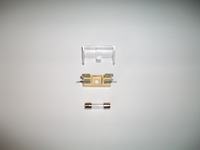- Joined
- Jul 4, 2009
- Messages
- 16,259
- Helped
- 5,140
- Reputation
- 10,309
- Reaction score
- 5,124
- Trophy points
- 1,393
- Location
- Aberdyfi, West Wales, UK
- Activity points
- 137,603
I'm wondering that as well.
The transistor is a 2SA1757 made by Rohm. It is a high speed switching transistor but there are no parts on your board which suggest it is used in a switching application so I think it is being used as a general purpose PNP transistor in this case. You can't tell anything about the board or the transformer from the part number I'm afraid.
If you want, you can try to test it but without proper analysis equipment all you will get is a go/no-go check:
If you have an analog testmeter (with a moving needle to show the reading)
use the lowest OHMs range, measure by swaping the probes around between the three pins, in one position you should get a reading from one pin to the other two, all other positions should give no reading.
If you have a digital meter (LCD or LED readout)
use the diode test range and do the same thing, you should get a reading of about 0.6 from one pin to the other two and nothing in any other position.
Brian.
The transistor is a 2SA1757 made by Rohm. It is a high speed switching transistor but there are no parts on your board which suggest it is used in a switching application so I think it is being used as a general purpose PNP transistor in this case. You can't tell anything about the board or the transformer from the part number I'm afraid.
If you want, you can try to test it but without proper analysis equipment all you will get is a go/no-go check:
If you have an analog testmeter (with a moving needle to show the reading)
use the lowest OHMs range, measure by swaping the probes around between the three pins, in one position you should get a reading from one pin to the other two, all other positions should give no reading.
If you have a digital meter (LCD or LED readout)
use the diode test range and do the same thing, you should get a reading of about 0.6 from one pin to the other two and nothing in any other position.
Brian.




